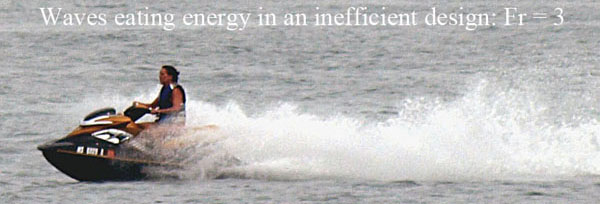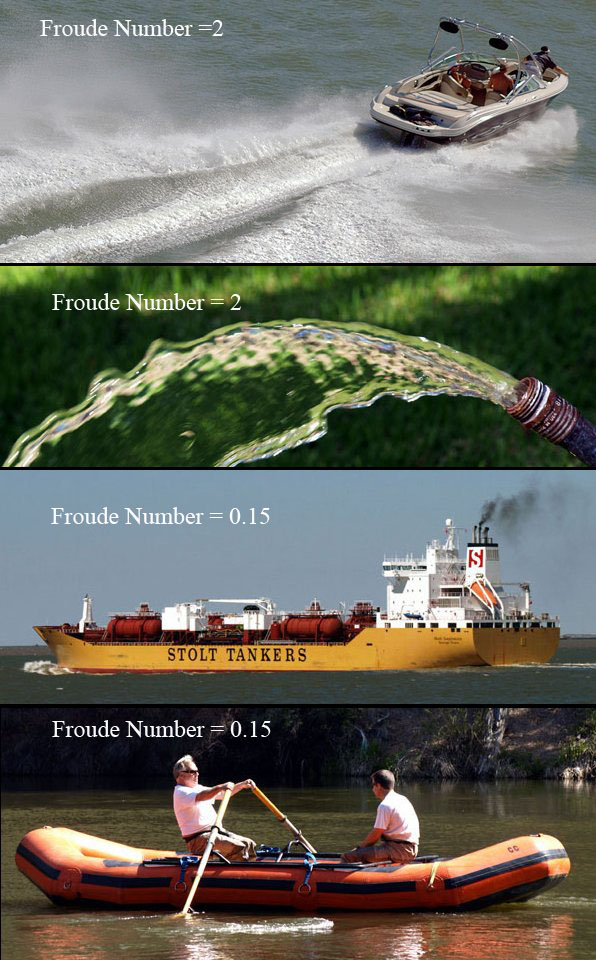William Froude
Today, meet William Froude. The University of Houston's College of Engineering presents this series about the machines that make our civilization run, and the people whose ingenuity created them.
We engineers often face the problem of comparing two dynamic situations. Think about a football, a bullet, and a baseball. When a quarterback makes a really hard pass, we call it a bullet because its trajectory is so flat. But look closely: Its path is not at all straight. We all know that pitchers try to fool batters with their balls' curved trajectories, even when the ball is moving ninety miles-an-hour.
A simple measure tells when such motions are equivalent. It's called a Froude Number -- the velocity divided by the square root of gravity-times-size. The Froude Number for a fast football is around ten; for a baseball it's maybe thirty; and it's close to 2000 for a rifle bullet. To act like a hard pass with a Froude Number of ten, a bullet would move out of a gun barrel at a scant ten miles an hour. So much for bullet passes!
William Froude was born in Devonshire in 1810, studied math at Oxford, and went on to work for the great British engineer Isambard Kingdom Brunel. Then Brunel asked him to study ships being powered through water. So he faced the problem of designing hulls whose waves caused the least drag. That action was far too complex to predict; it had to be measured. And who could afford to build twenty ships to find the best? Model testing had to be the answer.

Ship waves are dictated by the same physics as footballs and bullets. So, for a model to behave like its prototype, it had to move much more slowly -- slowly enough to give the same Froude Number as the full-sized ship. Froude had shown how to set the speed of the model so it'd behave just like the ship. We could now test the efficiency of a new ship design without building it.
William Froude was the middle of three brothers. His older brother Richard was an Anglican priest and a leader in the conservative high-church Oxford Movement. His younger brother James was a very famous British historian who strongly supported British Colonialism. And he did so in racially-charged terms.
But William was a mathematician/engineer. What his politics were, I do not know. I do know that his fame is much less than his flamboyant younger brother's. But his work has been essential to hydraulic design ever since. In Great Britain, he founded the Admiralty Experiment Works; it still does major ship testing today.
And my first professorship was at Washington State University where I worked in their vast hydraulics lab. They tested the dams, spillways, fish ladders, and so much more, that serve throughout the Pacific Northwest. And it was all done to the tune of Froude's modeling principles.
I've said before that politics comes and goes while we engineers shape the world. Did unassuming William Froude understand that fact? I hope so. For we have all reaped the benefits of his huge legacy -- in hydroelectric power, in water supply, in transportation, a legacy far greater than the mere fame of his brothers.
I'm John Lienhard at the University of Houston, where we're interested in the way inventive minds work.
See Wikipedia articles on William Froude, and his brothers James Anthony Froude and Richard Hurrell Froude. (Of the eight Froude siblings, I've mentioned only the most prominent.)
The Froude Number Fr is most commonly defined as V/sqrt(gL) where V is a characteristic velocity, g is a relevant acceleration (often gravitational acceleration) and L is a characteristic length -- all expressed in any consistent units. It may be interpreted physically as the square root of a comparison of a body's inertia with gravitation -- or as a comparison of a body's actual velocity with the speed it would gain as it fell through a distance equal to its own size.
Most engineers who've used the Froude Number have used it to analyze fluid flows strongly influenced by gravity. It may, however be used in any situation that is dominated by inertia and gravity (like bullets or basketballs.) For more on the use of dimensionless groups such as, and including, the Froude Number, see A Heat Transfer Textbook by Lienhard and Lienhard, Section 4.3.
The Laboratory in which I did much of my work during the early 1960s was the R. L. Albrook Laboratory at Washington State University. It then operated under the visionary leadership of one E. Roy Tinney who died young in 1974.

Some typical examples of fluid motion and the Froude Numbers for each. These are based on my approximations of size and speed in each case and are probably accurate within ten or twenty percent. (All photos by J. Lienhard)